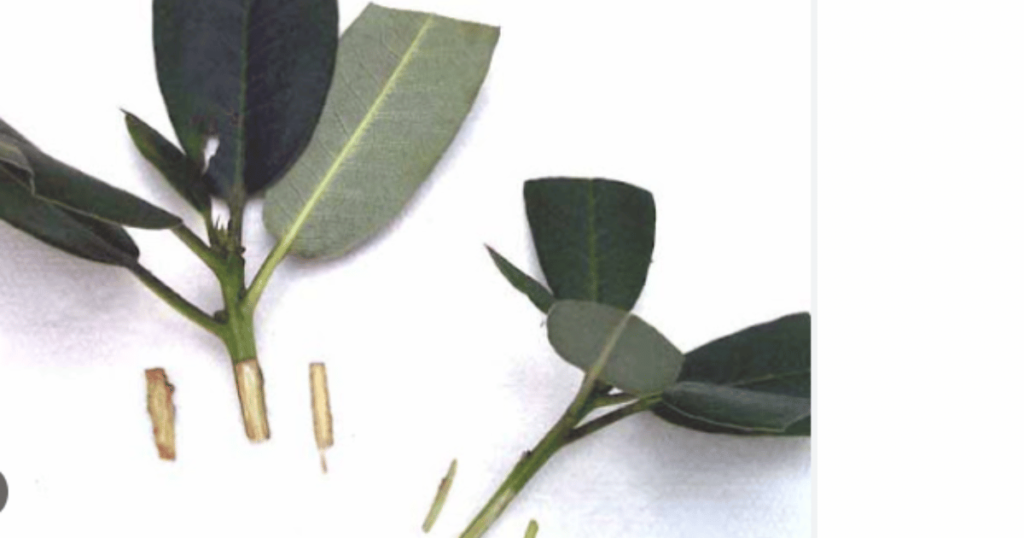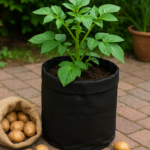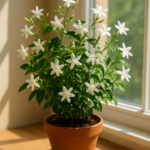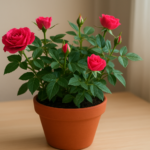Rhododendrons are super cool plants that add colour and greenery to any garden. They come in various types and colours, making them a favourite among plant lovers. These flowering shrubs belong to the genus Rhododendron, comprising numerous species and hybrids.
Did you know you can grow more rhododendron plants than the ones you already have? It’s called propagation, and it’s like creating clones of your favorite plants! It’s fun and lets you have more of your favorite blooms around.
So buckle up as we explore the exciting world of propagating rhododendrons and learn how to grow your own rhododendron army!
About Rhododendron Plant

Rhododendrons are stunning flowering shrubs cherished for their vibrant blooms and lush foliage. Belonging to the genus Rhododendron, these plants encompass various species and hybrids, offering gardeners multiple choices. They typically feature large, showy flowers in different colours, including shades of pink, purple, red, white, and even yellow. Rhododendrons are known for their ability to thrive in acidic soils and prefer partial shade, although some varieties can tolerate full sun. They are often found in woodland gardens and borders and are focal points in landscape design.
Beyond their aesthetic appeal, rhododendrons hold cultural significance in many regions. They symbolize beauty, grace, and even good fortune in some cultures. Additionally, certain species of rhododendrons have medicinal properties and are used in traditional medicine practices.
With proper care and attention, rhododendrons can provide years of beauty and enjoyment, making them a favourite among gardeners worldwide.
Why propagate Rhododendrons?
Propagating rhododendrons offers several advantages for gardeners and plant enthusiasts. Firstly, it allows individuals to expand their rhododendrons collection without purchasing new plants. This can be particularly beneficial for those with limited access to nurseries or speciality stores offering various rhododendron species and cultivars.
Secondly, propagating rhododendrons enables gardeners to preserve unique or rare cultivars that may be difficult to find commercially. By propagating from existing plants, individuals can ensure these unique varieties’ continued existence and availability.
Additionally, propagating rhododendrons can be a cost-effective way to beautify a garden or landscape. Instead of buying multiple plants, gardeners can propagate from a single specimen to create various new plants, saving money while still achieving their desired aesthetic.
Methods of propagation
There are several methods of propagating rhododendrons, each with its advantages and challenges. The main techniques include seed propagation, cuttings, layering, and division.
- Propagation by Seeds: This method involves collecting mature seeds from rhododendron plants, preparing them, and sowing them in a suitable growing medium. While seed propagation allows for genetic diversity, producing mature plants can take longer than other methods.
- Propagation by Cuttings: Cuttings involve taking a piece of stem or branch from a mature rhododendron plant and encouraging it to develop roots. Different types of cuttings are available, including softwood, semi-hardwood, and hardwood cuttings, each suited to specific times of the year.
- Propagation by Layering: Layering is a method where a portion of a rhododendron stem is bent and buried in the soil while still attached to the parent plant. This buried section develops roots, and once established, it can be separated from the parent plant to form a new individual.
- Propagation by Division: Division involves separating a mature rhododendron plant into multiple sections, each with its root system. This method is typically used for larger, established plants and is often employed to rejuvenate overcrowded or ageing specimens.
Each propagation method offers unique advantages and may be preferred depending on factors such as the desired outcome, available resources, and the characteristics of the propagated rhododendron species.
Propagation by Seeds

Collecting and Preparing Seeds:
To propagate rhododendrons from seeds:
- Start by collecting mature seeds from ripe seed capsules.
- Once collected, remove any debris or pulp from the seeds by rinsing them gently in water.
- Prepare the seeds for planting by stratifying them.
This involves storing the seeds in a relaxed, moist environment for some time, mimicking the natural conditions required for germination.
Sowing Seeds:
After the seeds have been appropriately stratified, sow them in a well-draining potting mix. Make shallow depressions in the soil and place the seeds inside, covering them lightly with a thin layer of soil. Water the seeds gently to ensure the soil is evenly moist.
Care and Maintenance of Seedlings:
Once the seedlings emerge, please provide adequate light and consistent moisture levels. Keep the soil moist but not waterlogged to prevent root rot. Once they have developed several sets of true leaves, transplant the seedlings into individual pots. Continue to care for the seedlings by providing them with proper nutrition, protection from pests and diseases, and appropriate environmental conditions until they are ready to be planted outdoors.
Propagation by Cuttings

Types of Cuttings:
When propagating rhododendrons from cuttings, there are several types to consider:
- Softwood Cuttings: These are taken from the current season’s growth, typically in late spring or early summer when the stems are still young and flexible.
- Semi-Hardwood Cuttings: These are taken from slightly older growth, usually in mid to late summer. The stems are more mature than softwood cuttings but flexible enough to root quickly.
- Hardwood Cuttings: These are taken from fully matured stems in late summer or early fall when the plant enters dormancy. Hardwood cuttings are more rigid and require longer to root than softwood or semi-hardwood cuttings.
Taking and Preparing Cuttings:
Select healthy stems from the parent rhododendron plant, ensuring they are free from pests, diseases, and damage. Use sharp, clean pruning shears to take cuttings, making diagonal cuts just below a leaf node. Remove any flowers or flower buds from the cuttings.
After taking the cuttings, prepare them by removing the leaves from the lower half of the stem. Dip the cut end of each cutting into a rooting hormone powder to encourage root development.
Rooting Process:
Place the prepared cuttings in a well-draining rooting medium, such as perlite or a mix of perlite and peat moss. Make sure the medium is moist but not soggy.
Provide the cuttings with bright, indirect light and maintain high humidity levels by covering them with a plastic dome or placing them in a propagator. Keep the rooting medium moist, but avoid overwatering, which can cause rotting.
Monitor the cuttings regularly for signs of root development, which typically takes several weeks to a few months, depending on the type of cutting and environmental conditions. Once roots have formed, transplant the cuttings into individual pots filled with potting soil and continue to care for them until they are ready to be planted outdoors.
How do you propagate rhododendrons by layering?
Propagation of rhododendrons by layering is a simple and effective method that encourages stems to develop roots while still attached to the parent plant. There are two main types of layering:
air layering and ground layering.
Air Layering:

- Select a healthy, flexible stem on the rhododendron plant you wish to propagate.
- Using a sharp knife, make a small incision or wound on the underside of the stem, about 6-12 inches from the tip.
- Dust the wound with rooting hormone powder to stimulate root growth.
- Wrap the wounded area with moist sphagnum moss or a similar rooting medium.
- Cover the moss with plastic wrap and secure it in place with twine or rubber bands to create a sealed environment for rooting.
- Check the moss periodically to ensure it remains moist, and observe for root development.
- Once roots have formed, carefully cut below the rooted section of the stem and transplant it into a pot filled with potting soil.
Ground Layering:
- Identify a low-growing branch on the rhododendron plant that can be easily bent down to the ground.
- Choose a spot along the branch where you can make a small incision or wound without damaging the branch.
- Make a shallow incision on the underside of the branch and dust it with rooting hormone powder.
- Secure the wounded portion of the branch to the ground using a U-shaped wire or a small stake.
- Cover the wounded area with soil, exposing the branch’s tip.
- Keep the soil consistently moist and monitor the branch for root development.
- Once roots have formed, sever the branch from the parent plant and transplant it into a pot or desired location in the garden.
Air and ground layering are effective methods for propagating rhododendrons and can yield new plants with minimal effort.
Propagation by Division:
Best Time for Division:
The best time to divide rhododendrons is typically in early spring or late summer. Dividing rhododendrons during these periods allows the plants to establish themselves before the onset of harsh weather conditions. Early spring division allows the plants to take advantage of the growing season ahead, while late summer division enables the roots to establish before winter.
How to Divide Rhododendrons:
- Prepare the Plant: Start by watering the Rhododendron thoroughly a day or two before dividing it. This ensures the plant is adequately hydrated and reduces stress during the division process.
- Dig up the Plant: Carefully dig around the base of the rhododendron plant, creating a broad and shallow trench. Be cautious not to damage the roots during this process.
- Separate the Sections: Gently lift the plant from the ground once it has been loosened from the soil. Inspect the root system and identify natural divisions or sections where the plant can be separated. Each section should have its own set of roots and shoots.
- Divide the Plant: Use a sharp knife or garden shears to divide the Rhododendron into individual sections. Make clean cuts, ensuring each section has enough roots and foliage to support its growth.
- Plant the Divisions: Replant the divided sections immediately into prepared holes in the garden or containers filled with well-draining potting mix. Position each division at the same depth as previously planted and water thoroughly to settle the soil around the roots.
- Provide Care: After planting, continue to water the divisions regularly to keep the soil evenly moist. Apply a layer of mulch around the base of the plants to conserve moisture and suppress weed growth. Monitor the divisions for signs of stress or wilting and provide additional care until they become established.
By following these steps, gardeners can successfully divide rhododendrons to create new plants and rejuvenate existing specimens.
Tips for Successful Propagation:
Ideal Conditions:
Well-Draining Soil: When propagating rhododendrons, use a well-draining potting mix or soil to prevent waterlogging, which can lead to root rot.
Partial Shade: Provide rhododendron cuttings or seedlings with partial shade to protect them from harsh sunlight, especially during the hottest part of the day.
Consistent Moisture: Maintain consistent moisture levels in the soil to promote healthy root development. Avoid overwatering, as excessive moisture can lead to fungal diseases.
Humidity: To prevent moisture loss through transpiration, maintain high humidity levels around propagating plants by covering them with plastic domes or placing them in a propagator.
Common Mistakes to Avoid:

Overwatering: Avoid overwatering rhododendron cuttings or seedlings, which can lead to root rot and other fungal diseases. Allow the soil to dry out slightly between waterings.
Excessive Fertilization: Refrain from applying excessive fertilizer to propagating rhododendrons, as this can cause fertilizer burn and damage delicate roots. Use a balanced, water-soluble fertilizer diluted to half-strength.
Improper Cutting Techniques: When taking cuttings, ensure clean, sharp tools are used to prevent damage to the parent plant and promote successful rooting. Make clean cuts below a leaf node and remove any flowers or buds from the cuttings.
Inadequate Rooting Hormone: To encourage root development, use rooting hormone powder or gel when propagating rhododendrons from cuttings. Apply the hormone to the freshly cut ends of the stems before planting.
Neglecting Environmental Conditions: When propagating rhododendrons, consider environmental factors such as temperature, humidity, and light levels. Provide the optimal conditions for successful propagation, adjusting as needed to ensure the health and vigour of the plants.
Will rhododendron cuttings root in water?
Yes, rhododendron cuttings can root in water, although there are more effective methods for propagating them. Rhododendrons are more likely to root successfully when using a well-draining rooting medium, such as perlite or a mix of perlite and peat moss, rather than water alone.
You can grow rhododendrons from cuttings. Taking cuttings from healthy, mature plants and following proper propagation techniques can yield new rhododendron plants with roots. Softwood or semi-hardwood cuttings taken during the appropriate season and treated with rooting hormone have the best chance of success.
Can a broken rhododendron branch be rooted?
Yes, a broken rhododendron branch can be rooted under the right conditions. If a branch breaks off from the parent plant, it may still have the potential to develop roots and grow into a new plant. By treating the broken end with rooting hormone and planting it in a suitable rooting medium, such as perlite or a mix of perlite and peat moss, you can encourage root development and potentially propagate a new rhododendron plant from the broken branch.
FAQ
- Can I propagate rhododendrons from leaf cuttings?
- Rhododendrons are typically propagated from stem cuttings rather than leaf cuttings, as stem cuttings have a higher success rate for root development.
- How long does it take for rhododendron cuttings to root?
- The rooting time for rhododendron cuttings can vary depending on factors such as the type of cutting, environmental conditions, and the health of the parent plant. Generally, it can take several weeks to a few months for cuttings to develop roots.
- Is it possible to propagate rhododendrons indoors?
- Rhododendrons can be propagated indoors using suitable containers, potting mix, and environmental conditions. Providing adequate light, humidity, and warmth can help facilitate successful propagation indoors.
- When is the best time to divide rhododendrons?
- The best time to divide rhododendrons is typically in early spring or late summer when the plants are actively growing but have yet to fully bloom. Dividing during these periods allows the divisions to establish themselves before harsh weather
Conclusion
In conclusion, propagating rhododendrons is a rewarding endeavour that offers numerous benefits for gardeners. Whether you choose to propagate by seeds, cuttings, layering, or division, each method allows you to expand your rhododendron collection, preserve unique cultivars, and enhance the beauty of your garden landscape. Following proper techniques and providing optimal care, you can successfully propagate rhododendrons and enjoy seeing new plants grow and thrive.
Read to know more: Propagating Chinese Money Plant: Tips and Techniques for Success







